Research Article Open Access
The Treatment of Shenzhen Coastal Polluted Water by Composites of Bio- Flocculants -Bacteria-Algae
| ZHANG Rui1,2,3*, YANG Xiao-Mao3, LU Li-Bin3, LiSi Dong2, ZHAO Zheng-ye3 and LI Gui-Feng1 | |
| 1State Key Laboratory for Biocontrol, School of Life Sciences, Sun Yat-Sen (Zhongshan) University, 135 Xingang West Road, Guangzhou, 510275, People’s Republic of China | |
| 2Center for Morden biochemistry, Guangdong Ocean University, Shenzhen, Guangdong, 524088, People’s Republic of China | |
| 3Shenzhen Key Laboratory for Coastal and Atmospheric Research Organization PKU-HKUST Shenzhen- Hong Kong Institution, Shenzhen, Guangdong, 518057, People’s Republic of China | |
| *Corresponding Author : | Zhang Rui State Key Laboratory for Biocontrol School of Life Sciences Sun Yat-Sen (Zhongshan) University 135 Xingang wester Road West Guangzhou, 510275, People’s Republic of China Tel: 020-84113792 E-mail: zhangr1168@163.com |
| Received August 24, 2013; Accepted November 06, 2013; Published November 11, 2013 | |
| Citation: Rui Z, Xiao-Mao Y, Li-BinLU, Dong L, Zheng-ye Z, et al. (2013) The Treatment of Shenzhen Coastal Polluted Water by Composites of Bio-Flocculants -Bacteria-Algae. Biochem Physiol 2:120. doi:10.4172/2168-9652.1000120 | |
| Copyright: © 2013 Rui Z, et al. This is an open-access article distributed under the terms of the Creative Commons Attribution License, which permits unrestricted use, distribution, and reproduction in any medium, provided the original author and source are credited. | |
Visit for more related articles at Biochemistry & Physiology: Open Access
Abstract
The polluted coastal water of Shenzhen Bay was treated with composites of active materials, bacteria and algae as well as combinations of two or three of these composites. The water quality was then examined after 10 days with a focus on 8 parameters, including dissolved oxygen (DO), suspended substances (SS), turbidity (Turbidity), ammonia nitrogen (NH4+-N), total nitrogen (TN), total phosphorus (TP), chemical oxygen demand (COD) and harmful marine vibrio. The results showed that the water quality was dramatically improved and the levels of harmful marine vibrio were significantly reduced after the treatment with the combination of active materials, bacteria and algae. The three composites can improve the rate of DO by 89.08% and had the highest removal rates of NH4+- N, TN, TP, COD and harmful marine vibrio (HMV), at 92.59%, 94.05%, 90.05%, 94.12% and 98.21%, respectively. However, the removal rates of SS and turbidity were the highest for the treatment with active materials compound with bacteria, at 95% and 92.69%, respectively. The combination of the three composites clearly had the best treatment effect for the restoration of polluted coastal waters. This study established solid theoretical and practical foundations to control coastal pollution and restore the coastal ecology.
| Keywords |
| Active materials (chitosan and sodium alga); Bacteria (nitrifying bacteria and Bacillus subtilis); Algae; Composite restoration; Polluted coastal water |
| Introduction |
| Coastal water pollution can cause eutrophication, frequent red tides and marine biodiversity damage. Thus, the heavy pollution of coastal waters is a serious problem all over the world [1-4], such as in the western coastal waters of Shenzhen Bay [5-7]. Coastal pollution has a negative effect on the ocean ecology and on the surrounding residents [8-11]. Some methods can be used to restore the pollution. A sustainable plant-based restoration method has been introduced from Europe [12]. Additionally, coastal mud flat wetlands have specific optimization functions [13-16]. Singapore has used bio-floating beds and other methods to treat the pollution in the neritic zone for the past 100 years, and the results have proven successful. The restorative plants can reduce the concentrations of nitrogen, phosphorus and other nutritive salts [17-19], and this technology was applied in a bio-floating bed [18,20-22]. The water quality and ecological characteristics in the demonstration area had improved [23,24]. |
| Flocculation-based precipitation technology has been widely used as the main technology to treat sewage [25-30]. It is a relatively cheap, efficient and quick method. In particular, biological polysaccharidebased materials used as adsorbents to treat polluted water represent an environmentally friendly method [31-33]. However, this method is seldom used in the treatment of polluted coastal waters. |
| Recently, microbial communities have been used to reduce the discharge of coastal sewage [34-40]. There are some reports on microbial compounds used in marine aquaculture wastewater restoration [41], but few on microbial compounds used in polluted marine water restoration. However, these microbial compounds have many unstable factors because of the mobility and openness of the neritic zone and tidal changes. Therefore, further efforts are needed to solve the problem of offshore pollution. Coastal water purification and silt clearance are greatly needed to restore the coastal ecology. |
| Materials and Methods |
| Study domain and sample collection |
| The study domain is located on the northwestern offshore of ShenZhen Bay. The coastal sewage collection occurred over a period of four months between October 2012 and January 2013. Dissolved oxygen (DO) was detected at the seashore immediately when the samples were collected. All samples were transported to the laboratory and analyzed within 2 hours. Water samples (black, smelly polluted water) were collected from ShenZhen Bay, located at E114 degrees (113.56’, 54.63”) and N23 degrees (22.33’ 43.79”) (H: 4.4 m, precision: 5.9 m). |
| Treatment methods of the polluted water and detection parameters of the water quality |
| The water quality was then detected after 10 days. The water quality analysis measured 8 parameters, including dissolve oxygen (DO), turbidity, suspended solids (SS), chemical oxygen demand (COD), ammonia nitrogen (NH3-N), total nitrogen (TN), total phosphate (TP), and harmful marine vibrio. The DO was determined in situ by a portable multiparameter analyzer (HACH, HD30, USA ). Other chemical parameters, such as COD, and the nutrients were determined according to the standard analytical methods for the examination of marine water and waste water. Harmful marine vibrio was cultured at 30ºC in TCBS (thiosulfate citrate bile salt sucrose agar) culture medium, and the number of single colonies was counted. |
| Active materials–bacteria–chlorella composited one another |
| The polluted water of Shenzhen Bay was treated with different combinations of two or three of the composites used in this study, active materials, bacteria and algae (Table 1). Treatment AB included the active materials and bacterium composites, AC included the active materials and chlorella composites, BC included the bacterium and chlorella composites, and ABC included the active materials, bacterium and chlorella composites. Thus, a total of four composite groups were used to treat the polluted water of Shenzhen Bay. The concentration of each composite was 10 ppm. The polluted water was first treated with the active materials at 10 ppm, followed by the addition of the bacteria and/or chlorella. Then, the water quality was detected after 10 days. The water quality analysis included 8 parameters, which were DO, turbidity, SS, COD, NH4+-N, TN, TP and harmful marine vibrio. |
| Results |
| Active materials–bacteria-chlorella purified the polluted coastal waters |
| The active materialss, bacteria, and chlorella each purified the polluted coastal waters (Figures 1-3). The results of Figures 2-4 showed that A (active materials, chitosan and sodium alga) had the best removal efficiency and highest removal rates for SS, turbidity and harmful marine vibrio (HMV), which were 94.23%, 86.6% and 89.29%, respectively. Additionally, B (bacterium, nitrifying bacteria+ Bacillus subtilis) had the best removal efficiency and highest removal rates for NH4+-N and TN, which were 74.20% and 75.83%, respectively. C (chlorella alone) had the best removal efficiency and highest removal rates for TP and COD, which were 88.11% and 83.33%, respectively. The DO value was greatly improved to 8.5 mg/L. |
| The removal rate (RR) of polluted matter |
| The removal rate (RR, compared with negative control) and the improved rate (IR) showed. The removal rate (RR, compared with negative control) of turbidity was 51.7~80.9%, and The removal rate (RR) of ammonium nitrogen (H4N+-N) was 66.2~80.1%. The removal rate (RR) of TN was 65.5~77.6%. The removal rate (RR) of COD was 56.6~91.2%. The removal rate (RR) of TP was 45.8~70.6%. Removal Rate of harmful marine vibrio was 70.9~97.1%. Among those flocculants, group1 (Ab) and group11 (PFeb) showed the best results (Figure 4). |
| The effects of treating the polluted water with active materialsbacteria- chlorella composited one another |
| Figure 5 shows the four groups of composites used to treat the polluted water of Shenzhen Bay. The effects of the different treatments, ranked from highest to lowest, on the water quality parameters were the following: DO improved rate (IR-DO), ABC>BC>AC>AB; SS removal rate (RR-SS), AB>ABC>AC>BC; turbidity removal rate (RR-Tur), AB>ABC>AC>BC; ammonia nitrogen removal rate (RR-NH4+-N), ABC>BC>AC>AB; TN removal rate (RR-TN), ABC>BC>AC>AB; phosphorus removal rate (RR-TP), ABC>AC>BC>AB; chemical oxygen demand removal rate (RR-COD), ABC>AC>BC>AB; and removal rate of harmful marine vibrio (RR-HMN), ABC>AC>AB>BC. |
| The highest removal rates for SS and turbidity were achieved with treatment AB (active materials and bacteria composites), at 95% and 92.69%, respectively, and the second highest were achieved with ABC (active materials, bacterium and chlorella composites), at 87.14% and 89.04%, respectively. The highest removal rates of NH4+-N and TP were achieved with treatment ABC (active materials, bacterium and chlorella composites), at 92.59% and 94.05%, respectively, and the second highest were achieved with BC (bacteria and chlorella composites), at 90.74% and 89.75%, respectively. The highest removal rates of TN and COD were achieved with treatment ABC, at 90.05% and 94.12%, respectively, and the second highest was achieved with AC, at 77.73% and 86.03%, respectively. The highest removal rate of harmful marine vibrio (HMV) was achieved with treatment ABC, at 98.21%, and the second highest was achieved with AB, at 94.64%. |
| Discussion |
| Coastal pollution control is a complex problem |
| Pollution abatement, pollution utilization and marine pollution restoration are very complex problems due to many unstabilizing factors, marine mobility, openness and tidal changes. Plants, wetlands, and microorganisms contribute to pollution abatement. Such methods, however, are costly given that the efforts of a team of 46 research scientists to control coastal pollution required 10 years. |
| Secondary pollution is the most worrying problem |
| The flocculation precipitation method is seldom used in coastal pollution control and restoration. The flocculation precipitation method is regarded as a quick, cheap and convenient method of pollution treatment for urban and industrial sewage, and it is widely used. However, it is seldom used in coastal pollution control and restoration. This paper attempts to apply the flocculation precipitation method to treat coastal pollution, especially in beach areas where the tidal dynamic is relatively poor and the pollution is serious and directly affects the marine environment. |
| In the future, biological treatment to wastewater is the goal |
| The most worrying problem of the flocculation precipitation methods is secondary pollution. Thus, the goal of the present study is to identify sewage treatment flocculants that are efficient, inexpensive, and environmentally friendly. Effective biological wastewater treatment with composite flocculants, such as sodium alginate chitosan, activated carbon, and cation starch will be a future research direction. |
| Marine active materialss and marine polysaccharides, such as chitosan and its derivatives, and others such as agar, algin, and alginic acid, are favorable flocculants for sewage treatment; they can effectively remove SS, ammonia nitrogen, TN and TP in wastewater and purify marine water for farming [42-45]. However, these flocculants could become more efficient for use in sewage treatment via molecular modification. The best ratios for compositing and screening still require further in-depth studies to eventually develop low-cost, environmentally friendly, efficient flocculants. |
| The process of microbial metabolism removes organic carbon from the sewage by degradation and transformation, changing it into carbon dioxide and components of the microbial composition itself [24,46,47]. Based on the above principles of microbiological water purification, Bacillus subtilis, which has a strong ability to decompose organic matter, is often selected as the dominant bacteria. It can also assist photosynthetic bacteria, denitrifying Bacillus subtilis, and lactic acid bacillus mixed agents while simultaneously eliminating harmful bacteria and performing synergistic functions [48]. Therefore, in this paper, the best complex bacteria were selected, which were nitrobacteria and Bacillus subtilis, and they had good effects. |
| Algae play a significant role in N and P removal and the adsorption of heavy metals and are also somewhat efficient with respect to COD removal. Biotechnology utilizing algae in water environmental protection has good prospects, not only for water quality monitoring but also for the ecological restoration of coastal sewage. The biosorption of metal ions may occur in the algal cell wall via cell surface functional groups. The basic mechanism of adsorption involves complexation of the metal cations and the functional groups on the surface of the algal cell wall. Thus, hydroxyl groups, amino groups, and carboxyl groups within alginate play important roles in the adsorption of heavy metals. |
| The combination of active materials-bacteria-chlorella composites is the best way to treat polluted coastal waters |
| Regardless of the method, restoration with a single composite was not sufficient to treat the ecological pollution of polluted coastal waters. |
| Active materials, bacteria and algae each have advantages, as follows: A, active materials mainly remove SS, turbidity and heavy metals; B, beneficial bacterium remove ammonia, phosphorus, chemical eutrophication products, biological oxygen demand, protein, fiber, pesticides, antibiotics, recalcitrant organics, and harmful bacteria and effectively treats turbid black rancid water and silt; and C, algae mainly affect the N and P concentrations and adsorption of heavy metals and also play a role in COD removal. |
| This paper fully utilized the three materials, active materialsbacteria- chlorella composites, and their complementary advantages to produce the best results for controlling coastal water pollution. |
| Conclusions |
| The results showed that the treatment with the combination of the three composites clearly had the best effect with respect to the restoration of polluted coastal waters. This study established a theoretically and practically solid foundation for coastal pollution control and ecological restoration. |
| Acknowledgements |
| We gratefully acknowledge past financial support from the “Shenzhen Double Hundred Project”. |
References
|
Tables and Figures at a glance
| Table 1 |
Figures at a glance
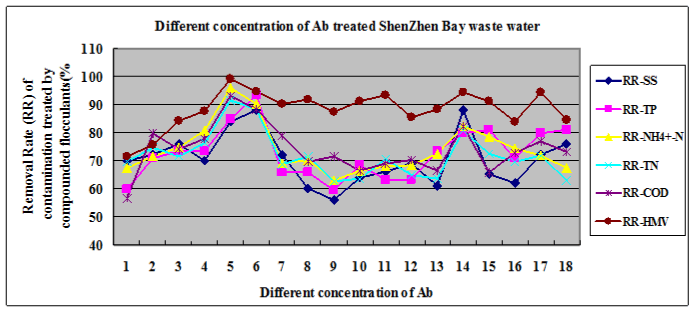 |
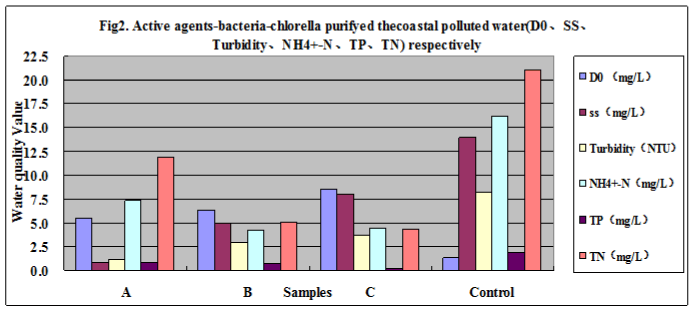 |
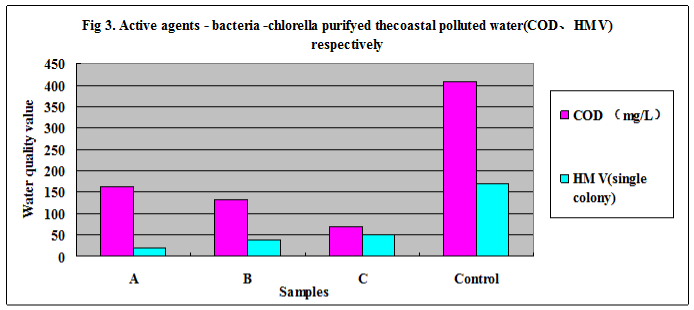 |
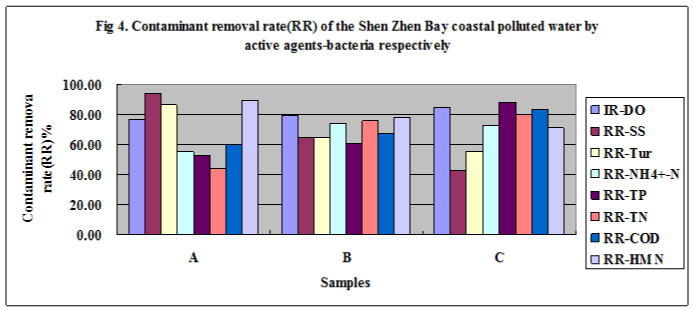 |
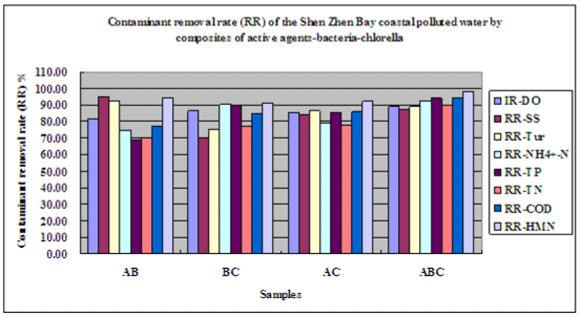 |
| Figure 1 | Figure 2 | Figure 3 | Figure 4 | Figure 5 |
Relevant Topics
- Analytical Biochemistry
- Applied Biochemistry
- Carbohydrate Biochemistry
- Cellular Biochemistry
- Clinical_Biochemistry
- Comparative Biochemistry
- Environmental Biochemistry
- Forensic Biochemistry
- Lipid Biochemistry
- Medical_Biochemistry
- Metabolomics
- Nutritional Biochemistry
- Pesticide Biochemistry
- Process Biochemistry
- Protein_Biochemistry
- Single-Cell Biochemistry
- Soil_Biochemistry
Recommended Journals
- Biosensor Journals
- Cellular Biology Journal
- Journal of Biochemistry and Microbial Toxicology
- Journal of Biochemistry and Cell Biology
- Journal of Biological and Medical Sciences
- Journal of Cell Biology & Immunology
- Journal of Cellular and Molecular Pharmacology
- Journal of Chemical Biology & Therapeutics
- Journal of Phytochemicistry And Biochemistry
Article Tools
Article Usage
- Total views: 15177
- [From(publication date):
November-2013 - Jul 02, 2025] - Breakdown by view type
- HTML page views : 10520
- PDF downloads : 4657
